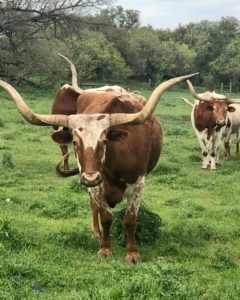LONGHORN FACTS:
The Texas Breed Cattle
“Other states were carved or born;
Texas grew from hide and horn.
Other states are long or wide;
Texas is a shaggy hide,
Dripping blood and crumpled hair,
Some gory giant flung it there…
Berta Hart Nance
As the poet says, the outline shape of Texas does resemble a cowhide spread on the ground. Its tail is represented by the peninsula at the southern Rio Grande border and the head and neck as the panhandle of the state. But the analogy goes far deeper than a shape on a map.
Texas owes its very existence to cattle. The earliest settlers depended upon the meat of black, long-horned feral Mexican cattle they hunted from the brush. The wild animals, or cimarrones, mixed with domesticated cattle brought from eastern states.
The result was a tough, rangy animal with long legs and horns, with spans extending to seven feet or more. Interbreeding produced a variety of colors: bluish-gray, several yellowish hues, browns, black, rusty red, and white, both cleanly bright and dirty-speckled.
The hardy longhorns adapted themselves to whatever conditions they found in Texas, be it arid desert wilds, or the impenetrable brush country of South Texas called la brasada. They thrived on coastal plains, or in swamps, or pine forests. They changed in appearance as their blood mixed to become the narrow-bodied, long-legged, wide-horned animal now known as the Texas Longhorn, a recognized breed of its own. Unlike the eastern cattle, early longhorns lived independently from man’s help.
Cattle were so common and money so scarce that a “cow and calf” represented the medium of exchange for early Texans. In the years following the Civil War, it is estimated that Texans drove from five to ten million longhorns to cattle markets at railroad heads in Missouri, Kansas, and Louisiana.
But fencing ranges caused the demise of the great herds. The lank animal’s ability to survive on the poor vegetation of the open range was not as important after pastures were enclosed. Other breeds gained weight more quickly for marketing.
Wild longhorn stock dwindled until in 1927, the breed was saved from near extinction by the United States Forest Service. They collected a small breeding herd to range the Wichita Mountains of Oklahoma. J. Frank Dobie and others gathered and financed small herds to graze in Texas state parks. In 1995, the Texas Legislature designated the Texas Longhorn as the (large) state mammal.

LONGHORN FICTION from Beneath the Texas Sky
The brush rustled and a dun-colored longhorn cow pushed around a juniper shrub. She stopped, head in the air, staring intently in their direction. She didn’t move, and neither did Print or Julie.
“Look at the ground under that small cedar bush in the tall grass and tell me what you see,” he whispered.
At first, Julie obviously saw nothing, her face a blank, but as she continued to stare at the spot, a smile formed. “A calf. It’s barely visible—almost the same color as the ground, and lying flat with its chin on the ground. How enchanting.”
”Enchanting—I’ll have to teach that word to Zeke, the new cowboy I hired.” Print chuckled.
“So tiny. Does it belong to that cow?”
“Maybe the calf is hers. Her own is certainly there, but so are several others, likely hiding in the grass. She may be the nanny of that one, watching a nursery while other mothers go to water. She’ll go when they return. Each cow recognizes the bawl of her own calf and can pick it out of a hundred others.” Julie had not moved.
Print continued softly, “In longhorns, the protective instinct of the female is especially strong. The only help a bull gives in rearing the calf may be hooking off a predator. Cows keep their calves hidden until they’re strong enough to run.”















